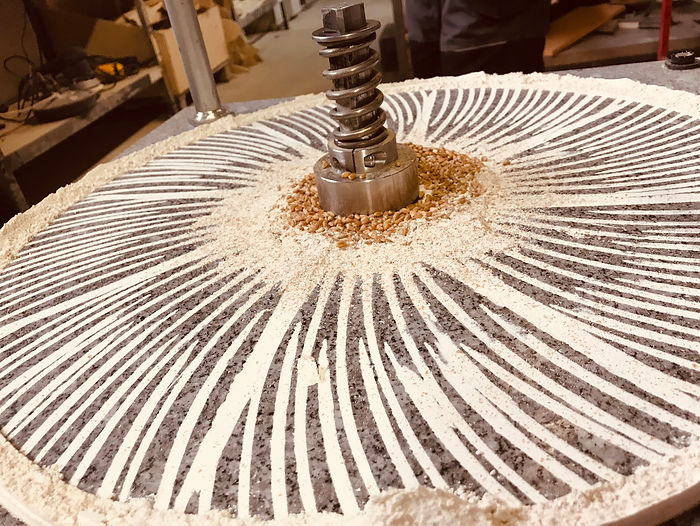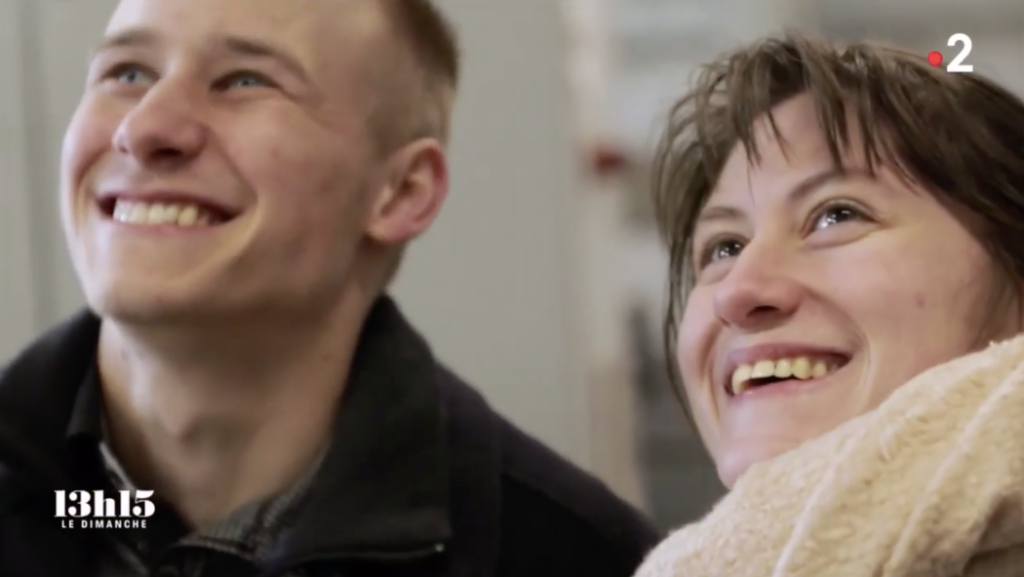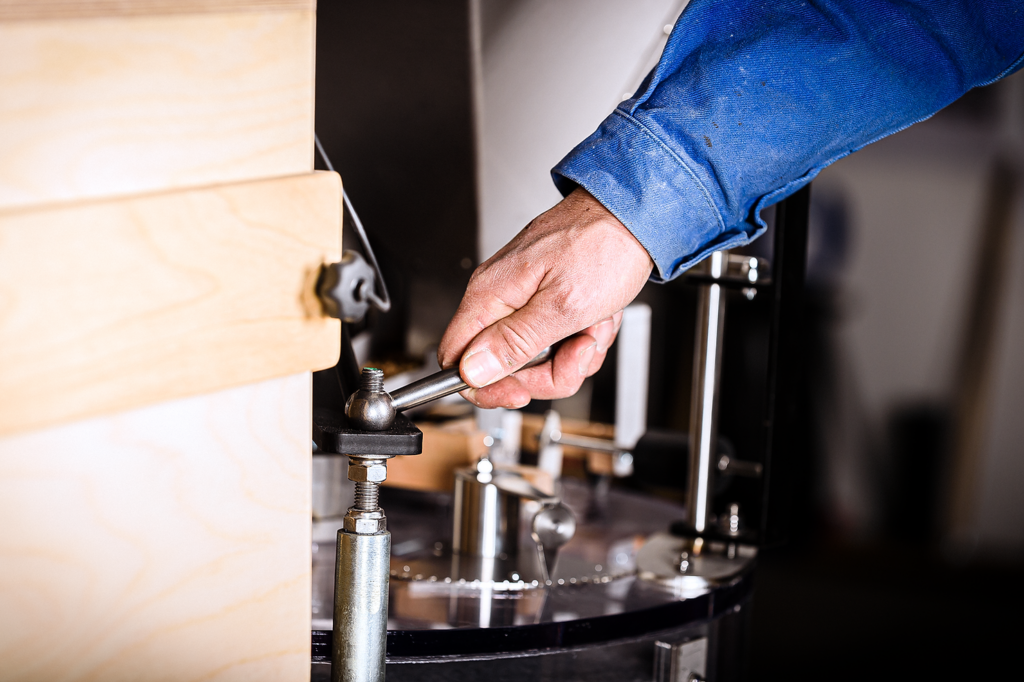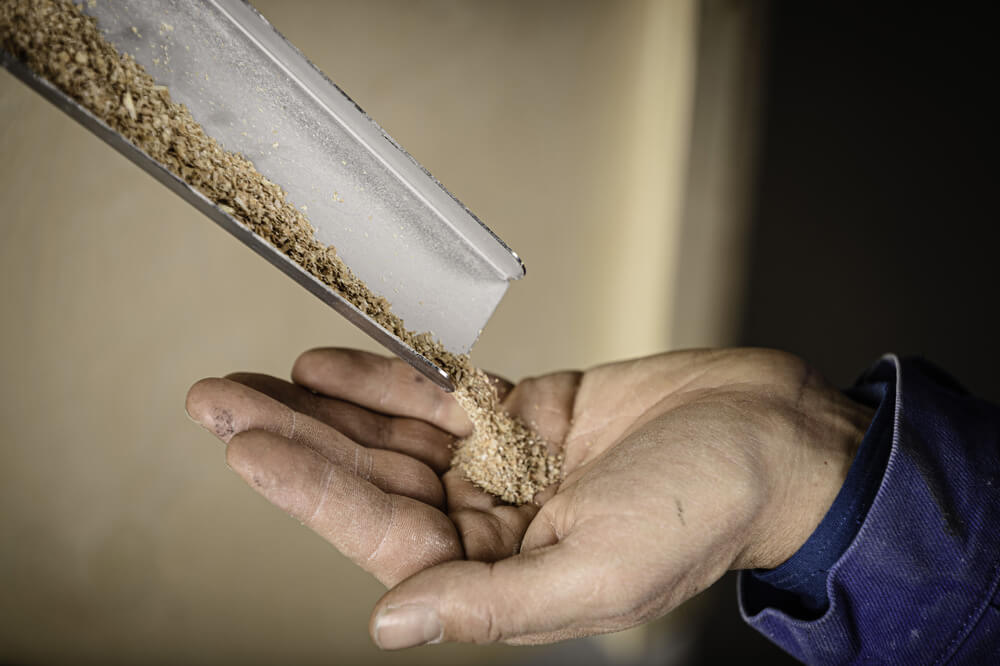That’s what we’re going to talk about today.
Key 1: Principle of regular maintenance
Stone millstones wear out from use of your mill. The term is historical. On a traditional stone mill, a person would come and iron and dress the millstones directly on site. The mill was heavy, and the weight of the millstones crushed the grain (which is no longer the case with an Astrié flour mill, as we make it).
The millstones of a traditional grindstone mill were concave and convex and tended to flatten out with the daily grinding work. So the repiqueur came in to give the millstones back their shape and sharpness. This obviously depended on the type of grain being crushed and how often the mill was used.
In the case of an Astréïa mill, there is no longer this concave/convex aspect, the grindstones no longer crush the grain because of their weight, but the granite wears down over time. What are we here to do?
- the furrows are sharpened
- very little material is removed
- we redraw what has worn away
- we re-draw designs that have worn over time, especially on the flywheel

Key 2: What is the practical use of refurbishing the grinding wheels on an Astrié-type flour mill?
The purpose of this cutting edge is to maintain the extraction rate.
The more the millstones wear, the more the extraction rate and the yield of the mill will be affected. Restoring the sharpness of the grooves and patterns on the millstones guarantees that the extraction rate and yield (kilos per hour) will be restored.
Failing that, we often use ‘smooth’ grinding wheels to bring the millstones closer together by manually adjusting the mill, but the yield will still be impaired.
The purpose of this refitting is to enable you to keep
- cost-effective equipment
- energy-efficient equipment.

Key 3 : How often do I need to refurbish the millstones on my Astréïa flour mill?
This will depend on a number of factors:
- the quality of the cereal mix you unroll
- the type of grain you unroll
- the quantity of grain you unroll in your flour mill
The quality of the cereal mix
If you intend or are in the habit of passing cereals through your mill in which there are still clods, fine gravel (…), the passage of this material between the millstones will prematurely wear out the cutting edge of the millstones.
Ideally, of course, the mixture should be clean, brushed, sorted and properly moistened before passing through your Astrié stone mill (whether it’s an Astréïa mill or any other mill for that matter!).
The type of grain
Some grains are harder than others. For example, buckwheat will ‘wear out’ the cutting edge of your grindstones twice as fast as soft wheat. Durum wheat will put more strain on the cutting edge than soft wheat, rye or small spelt, which are softer cereals.
The amount of grain unrolled
Obviously, the more you use your mill, the harder the grinding wheels will work.
With soft wheat that has been sorted, brushed and wet, for example, you can use your mill without having to dress your millstones for around 40 tonnes of wheat with an Astréïa mill whose millstones measure 50 cm in diameter, or 100 tonnes with an Astréïa mill measuring 100 cm (since the surface area is increased by 4).
This re-dressing is therefore necessary, but you’re not a week or a month away. The main thing is to remember to carry out this maintenance and upkeep.
Key 4: Know-how and skills
Dressing grinding wheels requires know-how. You need to have :
- common sense
- the right tools (simple)
- the right angle
- experience to get the hang of it, without damaging the stone while giving the right edge
It’s a simple skill to acquire, as it doesn’t involve cutting the wheels from a flat block of granite, but rather restoring the sharpness of the designs that will already be present on your wheels.

However, this remains a skill, because without this key skill you can damage the millstones and have a clear and direct impact on the output and efficiency of the mill. If you go too far, if you go at the wrong angle, if you go too deep, you could end up crushing the wheat instead of unrolling it to make flour. That’s the risk.
So the idea is to do things right so as not to impair your efficiency.
This implies a constraint: dressing your millstones at regular intervals. Just as you would change the oil in a car, re-dressing the millstones is an essential part of maintaining and servicing your milling equipment.
Key 5: How do things work in practice for my mill?
Together, we’ll plan to return the mill to Astréïa to refurbish the millstones. What exactly will we be doing during this overhaul?
- we bring your mill up to date with the technical improvements we make to all our machines
- we refurbish the grinding wheels
- we re-balance the grinding wheel, since some material will have been removed, so it’s absolutely essential to re-balance the flywheel
- we check the parallelism
- we re-test the mill to validate all the previous steps
This involves immobilising your mill, your time and the cost of this service. In general, you should allow a day for this (1/2 day’s work and 1/2 day’s travel).
Some of our customers prefer to send us the mill and we send it back to them, which saves you time and energy. We would strongly advise you to choose only delivery drivers who work on a ‘no-break’ basis (the mill remains in the lorry and does not pass through a logistics platform). In this case, you can count on downtime of around a week if we have worked out the transport times in advance and scheduled the workshop appointment accordingly. This also means preparing a sufficient stock of flour for your week without the mill.
Eventually, we plan to come to your premises to do this re-dressing. You’ll know when we’ll be near you, and we can then schedule a visit to your premises to carry out the overhaul.
Are you in a particular situation? Let’s talk about it together.
Key 6: Who is in charge of this refurbishment at Astréïa?
At Astréïa, we believe that customer care is just as important as all the information we give you before you buy. That’s why our workshop manager, Yannis Renaud, is responsible for liaising technically with all our customers. He is also there to support you and answer all your technical questions after your training with us.
He’s also in charge of the grinding wheel refurbishment work, which is one of the prerequisites for the profitability of your equipment.
We look forward to discussing your project with you.



